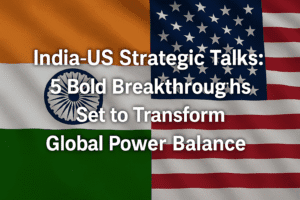India-US Strategic Talks: 5 Bold Breakthroughs Set to Transform Global Power Balance
Foreign Secretary Vikram Misri’s Washington visit (May 27-29) accelerated efforts to transform the ambitious India-US COMPACT agreement into concrete action. High-level talks across US defense, trade, and security agencies prioritized operationalizing defense co-production – particularly jet engines – alongside deeper military interoperability and logistics frameworks.
Critical trade discussions focused on finalizing the bilateral agreement and streamlining complex US export controls (ITAR) hindering technology transfer. Collaboration in critical technologies like AI and semiconductors was advanced through direct industry engagement, while global coordination covered financial security (FATF) and strategic initiatives (Quad, IMEEC).
The visit underscored both nations’ urgency in cementing a technology, trade, and talent-driven alliance, recognizing its vital role in navigating intensifying global competition. Success now hinges on tangible progress, notably in defense manufacturing deals and resolving persistent bureaucratic hurdles. This intensive diplomacy signals a pivotal shift from high-level vision to hard implementation.

India-US Strategic Talks: 5 Bold Breakthroughs Set to Transform Global Power Balance
Foreign Secretary Vikram Misri’s recent high-level visit to Washington D.C. (May 27-29) wasn’t just another diplomatic exchange; it was a focused, high-stakes effort to translate the ambitious vision of the India-US partnership into concrete action. Building directly on Prime Minister Modi’s February visit and the landmark “COMPACT for the 21st Century” initiative, Misri’s whirlwind of meetings across the US administration signals a critical phase in the relationship, centered on defence co-creation, trade resilience, and technological leadership.
The Pillars of Partnership: Defence, Trade, Talent
The COMPACT framework explicitly anchors the relationship on Technology, Trade, and Talent. Misri’s engagements meticulously addressed each:
- Defence: Moving Beyond Buyer-Seller to Co-Creator:
- Deepening Integration: Discussions with US Deputy Secretary of Defence Steve Feinberg and Under Secretary for Policy Elbridge Colby moved beyond symbolic exercises. The focus was squarely on operationalizing co-production and co-development initiatives – crucial for India’s ‘Atmanirbhar Bharat’ (Self-Reliant India) goals and US strategic supply chain diversification.
- Jet Engines & Beyond: While not explicitly stated in every report, the context heavily implies the GE-HAL jet engine deal and similar high-tech defence collaborations were central. Progress here is a litmus test for the partnership’s ambition.
- Foundational Frameworks: Sustaining complex joint exercises, finalizing robust logistics agreements (like reciprocal logistics support), enhancing secure information-sharing, and boosting interoperability are the bedrock for credible deterrence, particularly in the Indo-Pacific.
- Trade & Commerce: Untangling Knots, Building Bridges:
- Bilateral Trade Agreement (BTA): Talks with Under Secretary of Commerce Jeffrey Kessler directly tackled the BTA. While “well on track” signals optimism, the real hurdles lie in market access, agricultural standards, and digital trade rules. An early convening of the Strategic Trade Dialogue is vital for momentum.
- The ITAR/Export Control Challenge: A recurring thorn, streamlining US International Traffic in Arms Regulations (ITAR) and broader export controls is essential for seamless technology transfer and co-development, especially in defence and dual-use tech. US willingness to adapt here is a key indicator of trust.
- Economic Security & Finance: Discussions with Deputy Treasury Secretary Michael Faulkender extended beyond bilateral trade to coordinating positions in global financial bodies (IMF, World Bank) and critical efforts like the FATF, impacting counter-terrorism financing – a shared priority.
- Technology & Talent: The Engine of the Future:
- Critical & Emerging Tech (CET): The joint roundtable with industry leaders wasn’t ceremonial. It aimed to unlock private sector collaboration in semiconductors, AI, quantum computing, and space tech – areas where combined strengths can counterbalance other global players.
- The “Talent” Imperative: Recognizing India’s human capital as a strategic asset, discussions implicitly touched on visa pathways for skilled professionals and researchers. Facilitating the movement of talent is vital for driving the CET agenda and innovation ecosystems in both nations.
- TRUST Initiative & Tech Security: Collaboration on telecommunications security (including 6G) through initiatives like TRUST and secure digital infrastructure development was part of the broader strategic discussions.
The Broader Strategic Canvas:
The talks consciously placed the bilateral agenda within wider regional and global frameworks:
- Quad & I2U2: Reinforcing coordination within these minilateral groups amplifies both nations’ influence in the Indo-Pacific and West Asia.
- Indian Ocean & IMEEC: Discussions on the “Indian Ocean Strategic Venture” and the India-Middle East-Europe Economic Corridor (IMEEC) highlight shared interests in maritime security and resilient connectivity alternatives.
- Counter-Terrorism: A persistent shared threat, requiring ongoing intelligence and operational coordination.
Why This Visit Matters Now:
Misri’s trip underscores a pivotal transition:
- From Vision to Execution: The COMPACT is no longer just aspirational; this visit was about hammering out implementation roadmaps and resolving bottlenecks.
- Geopolitical Imperative: In a world marked by strategic competition, a functional and deep India-US partnership is increasingly seen in both capitals as indispensable for regional stability and a free, open Indo-Pacific.
- Mutual Dependency: The US seeks a capable democratic partner in Asia; India seeks advanced technology, investment, and strategic space. Both need tangible results to sustain domestic political support for the partnership.
The Road Ahead: Watching for Concrete Outcomes
The true measure of success will lie in what follows:
- Speed on Defence Co-Production: Concrete announcements on jet engines or other major co-development projects.
- Progress on BTA & Export Controls: Visible steps towards resolving trade disagreements and simplifying technology transfer hurdles.
- CET Project Launch: Announcing specific, funded joint technology initiatives emerging from industry consultations.
- Next Steps on Dialogues: Prompt scheduling of the Strategic Trade Dialogue and other follow-on meetings.
In essence, Foreign Secretary Misri’s visit was a high-pressure diplomatic push to transform the ambitious rhetoric of the India-US “Comprehensive Global Strategic Partnership” into the hard, collaborative work of shared security, technological advancement, and economic resilience. The coming months will reveal whether both sides can navigate the complexities and deliver the substantive outcomes this critical relationship demands.
You must be logged in to post a comment.